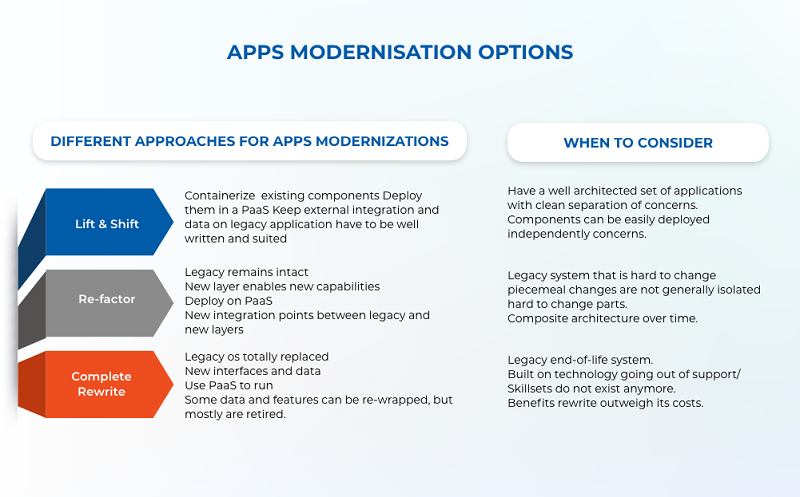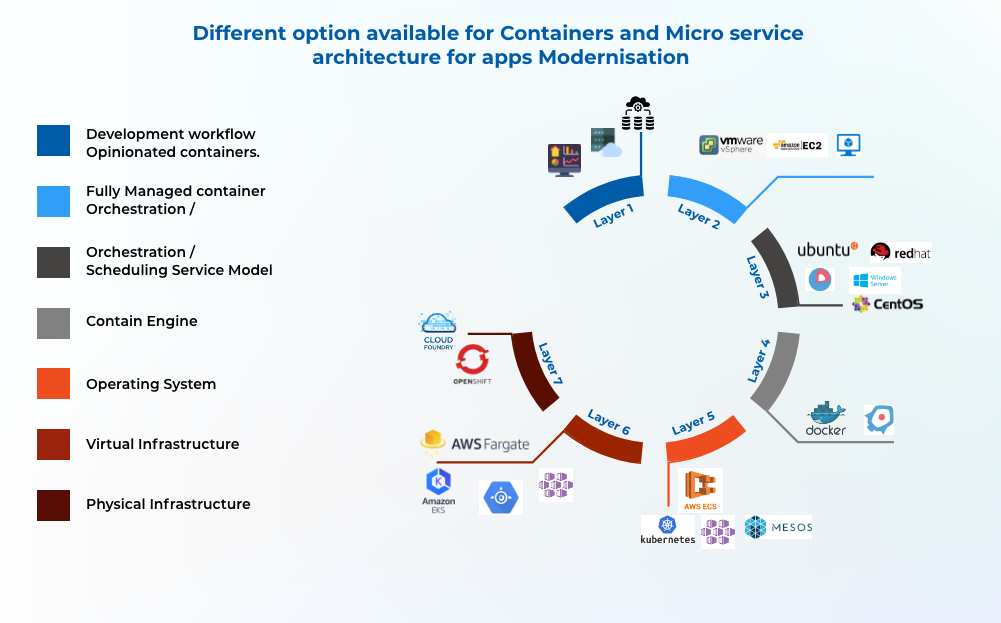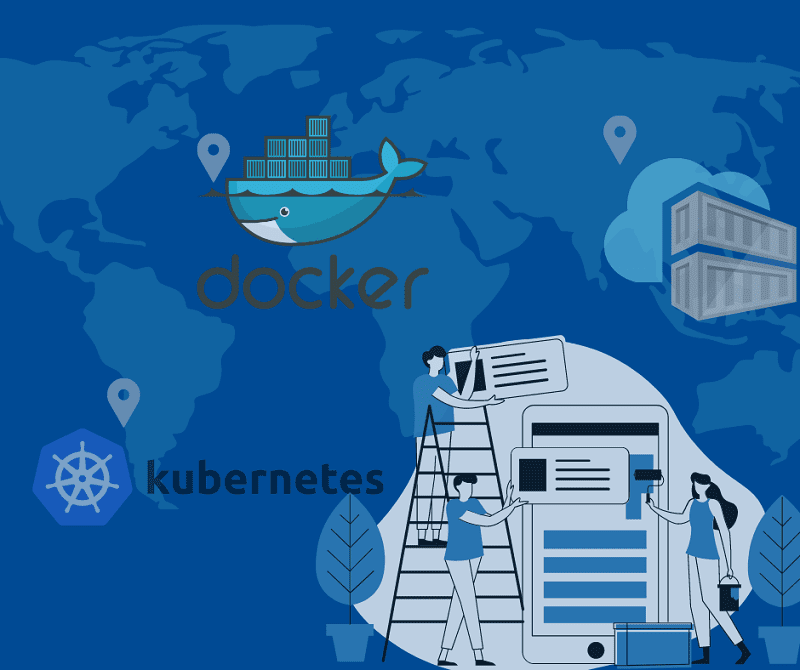Legacy applications are generally built over monolithic design with a three-tier structure: front, middle, and end layers. These sorts of monolithic designs reduce agility and flexibility of applications because it is compressed and results in scalability-challenges that bars meeting business requirements. This challenge has paved the way for re-structuring legacy applications in a modernized manner using Microservices and Containers.
Why do we need to modernize applications?
Modernizing legacy apps using microservices and containers cut off’s the rigidity of applications by deploying container framework. In addition, extended manageability, automation, and better mobility can be accomplished by re-structuring the application into the container architecture. Plus, security and governance become added into the pack as add-ons.
The most remarkable part is it is possible to run these containerized applications without any dependencies or VM’s (virtual machines). As the containers run on their own operating systems, they eliminate these dependencies.
How can you select the ideal applications for application modernization?
Before heading to adopt the concept of containerization, we must cross-check the existing legacy applications. At times, many legacy applications can be unfit for containerization. Wrong choices lead to irrecoverable dilemmas.
So, having a comprehensive study to choose the best helps a lot before adopting containerization as your ideal application modernization option. Besides, avoiding apps with outdated languages like Fortran, Cobol, and mainframe-based apps will save you from unwanted troubles.
Because, poorly designed applications will have to be worked a bit more to bring it to a cloud-ready appearance. If the applications need a full-cycle modification, it would be much cost-effective and easier to develop a new application rather than modernizing it.
To illustrate, applications that are rigidly paired with the data sets are difficult to migrate to the cloud platform and containerize the data sets to give a fresh and flexible performance. So, instead of exhausting our time and effort, developing a new application would be an optimal option.
Further, in terms of the application run time environment, containers will assure developers to completely “own” the configuration and setting up of their application. The build Pipeline will make containers to be kept in different pre-production environments like testing the integration, loading, and then production units of the pipeline to be deployed. It can also ease the deployment toolchain of DevOps, which does not require differentiation based on their runtime artifact type, for instance, PHP vs. JVM. Each and every runtime variation is confined within the container.
Need of Modernization
Fulfilling the market demands is the need of the hour, which is heavily dominated by digital transformations and disruptions. It is a process of moving from structural legacies to the latest technologies in order to create a positive result for the business.
Applications are the core of this digital disruption that always meets the business demands, making modernization a quintessential factor in meeting the market demands. Microservices and Containers are the easiest ways to travel in the right direction to the technological field changes.
Containerization and Microservices catalyze scalability of applications for independent operations, accessibility of the system, and the implementation of new services rapidly without moving through enormous reconfigurations. This, in turn, increases the speed of distribution and enhances protection in our environment’s scalability and availability.
Merits of Containers and Microservices with regard to Architecture
- Removal of team dependencies, resulting in quicker code for output.
- Numerous simultaneous initiatives to run.
- Encourages different technologies, languages, and frameworks.
- Enables uninterrupted and seamless degradation of operations and services
- Promotes innovation by disposable codes
More About Business Value
The architecture of microservices ensures faster app delivery, which is essential to remain ahead of the competition and attain sustainable development. The key to company principles that drive the speed of delivery and greater availability:
- Agility helps companies to produce new products more efficiently with better speed.
- Performance efficiency reduces the time for production by reusability over time.
- Allows new opportunities to emerge faster through streamlined planning for growth, which elevates accuracy.
- Provides further pilot and opportunities by independent deployment of prototypes.
- Encourages teams to develop more complex products and functions iteratively.
- Using the right tools for the correct task ensures a quick response.
- Reduces costs for maintenance and the chance of outages due to capacity problems.
- Stronger resilience and greater accessibility
Scalability enables the program to expand with business requirements or shrink them. We should evaluate our requirements based on which we can build our architecture for microservices by looking at business priorities that incorporate the possible advantages of microservice architecture.
App Modernization Options:

When embarking on an existing container app, we need to remember the following aspects:
- Check possibilities on containers to onboard current apps, which can be natively put on containers within the PaaS or the container platform for native schedulers.
- Check options for current onboard applications with slight modifications. When accessing applications, use the service-broker, Edge Gateway or API service. Several software, such as legacy databases or services that operate on a mainframe, should remain unchanged and available only via a service broker within the platform.
- If the above mentioned options are omitted, then we must look at the alternative of rewriting the application. This is going to be slightly costly, and efforts need to be put in and must be made with a proper strategy for risk control. The benefits of rewriting would make it possible for companies to deliver new goods quickly and more effectively. It restores initial expenses and efforts in a few month’s span.

Containers: Docker, an open-source container implementation based on Linux. Platform as a service such as Google App Engine, Redhat Open Shift, and the Cloud Foundry by VMware (LXC).
Container Orchestration: Docker Swarm, Kubernetes, Apache Mesos, AWS ECS, Azure ACS.
Fully Organized Container Orchestration Services: AWS EKS, Azure AKS, AWS Fargate, Google GKE.
Development Workflow Opinionated Containers: Redhat, Openshift, Cloud Foundry
The Role Played by Containers and Microservices in the Digital Transformation Journey
As CaaS (Containers as a Service) is all set to turn the IT space, its performance will also depend on developing technology, the process, and the aligned people for this transformation. As per the industry veterans, the USA has already begun to embrace containerization as a service and modernize legacy applications.
As a digitally powered IT solutions company, ZiniosEdge offers application modernization using Containers and Microservices. ZiniosEdge works with clients to ensure that the easiest and the most innovative applications are designed using Microservices and Containers leveraging Agile, DevOps, and other effective approaches, which have often turned to be the best methods and technology for the application modernization process.

